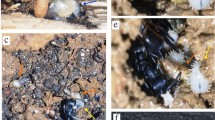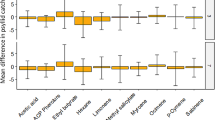Abstract
Plant-feeding insects use visual and olfactory cues (shape, color, plant volatiles) for host location, but the relative importance of different cues and interactions with non-host-plant volatiles in ecosystems of varying plant biodiversity is unclear for most species. We studied invasive bark beetles and wood borers associated with pine trees to characterize interactions among color, host and non-host volatiles, by employing traps that mimic tree trunks. Cross-vane flight intercept traps (black, green, red, white, yellow, clear) and black funnel traps were used with and without attractants (α-pinene + ethanol), repellents (non-host green leaf volatiles, ‘GLV’), and attractant/repellent combinations in four pine forests in New Zealand. We trapped 274,594 Hylurgus ligniperda, 7842 Hylastes ater, and 16,301 Arhopalus ferus. Trap color, attractant, and color × attractant effects were highly significant. Overall, black and red traps had the highest catches, irrespective of the presence of attractants. Alpha-pinene plus ethanol increased trap catch of H. ligniperda 200-fold but only 6-fold for H. ater and 2-fold for A. ferus. Green leaf volatiles had a substantial repellent effect on trap catch of H. ligniperda but less on H. ater and A. ferus. Attack by H. ligniperda was halved when logs were treated with GLV, and a similar effect was observed when logs were placed among broadleaved understory shrubs emitting GLV. Overall, H. ligniperda was most strongly affected by the olfactory cues used, whereas H. ater and A. ferus were more strongly affected by visual cues. Collectively, the results support the semiochemical diversity hypothesis, indicating that non-host plant volatiles from diverse plant communities or artificial dispensers can contribute to resistance against herbivores by partly disrupting host location.





Similar content being viewed by others
References
Baldwin IT (2010) Plant volatiles. Curr Biol 20:R392–R397
Barbosa P, Hines J, Kaplan I, Martinson H, Szczepaniec A, Szendrei Z (2009) Associational resistance and associational susceptibility: Having right or wrong neighbors. Annu Rev Ecol Evol Syst 40:1–20
Benjamini Y, Yekutieli D (2001) The control of the false discovery rate in multiple testing under dependency. Ann Stat 29:1165–1188
Bernays EA, Chapman RF (1994) Host-plant selection by phytophagous insects. Chapman & Hall, New York
Branco M, Brockerhoff EG, Castagneyrol B, Orazio C, Jactel H (2015) Host range expansion of native insects to exotic trees increases with area of introduction and the presence of congeneric native trees. J Appl Ecol 52:69–77
Briscoe AD, Chittka L (2001) The evolution of color vision in insects. Annu Rev Entomol 46:471–510
Brockerhoff EG, Hosking GP (2001) Arhopalus tristis (F.)(Coleoptera: Cerambycidae) (= Arhopalus ferus (Mulsant)): Burnt pine longhorn beetle. Forest and Timber Insects in New Zealand 27:1–8
Brockerhoff EG, Bain J, Kimberley M, Knížek M (2006a) Interception frequency of exotic bark and ambrosia beetles (Coleoptera: Scolytinae) and relationship with establishment in New Zealand and worldwide. Can J Forest Res 36:289–298
Brockerhoff EG, Jones DC, Kimberley MO, Suckling DM, Donaldson T (2006b) Nationwide survey for invasive wood-boring and bark beetles (Coleoptera) using traps baited with pheromones and kairomones. For Ecol Manag 228:234–240
Brockerhoff EG, Kimberley M, Liebhold AM, Haack RA, Cavey JF (2014) Predicting how altering propagule pressure changes establishment rates of biological invaders across species pools. Ecology 95:594–601
Bruce TJA, Pickett JA (2011) Perception of plant volatile blends by herbivorous insects - Finding the right mix. Phytochemistry 72:1605–1611
Byers JA, Zhang QH (2012) Chemical ecology of bark beetles in regard to search and selection of host trees. In: Recent advances in entomological research. Springer, p 150–190
Byers JA, Zhang QH, Birgersson G (2004) Avoidance of nonhost plants by a bark beetle, Pityogenes bidentatus, in a forest of odors. Naturwissenschaften 91:215–219
Campbell SA, Borden JH (2006) Integration of visual and olfactory cues of hosts and non-hosts by three bark beetles (Coleoptera: Scolytidae). Ecol Entomol 31:437–449
Campbell SA, Borden JH (2009) Additive and synergistic integration of multimodal cues of both hosts and non-hosts during host selection by woodboring insects. Oikos 118:553–563
Castagneyrol B, Jactel H, Vacher C, Brockerhoff EG, Koricheva J (2014) Effects of plant phylogenetic diversity on herbivory depend on herbivore specialization. J Appl Ecol 51:134–141
Chase KD, Kelly D, Liebhold AM, Bader MK-F, Brockerhoff EG (2017) Long distance dispersal of non-native pine bark beetles from host resources. Ecological Entomology
De Jong MCM, Sabelis MW (1988) How bark beetles avoid interference with squatters: An ESS for colonization by Ips typographus. Oikos 51:88–96
Doering TF, Chittka L (2007) Visual ecology of aphids-a critical review on the role of colours in host finding. Arthropod Plant Interact 1:3–16
Drever MC, Goheen JR, Martin K (2009) Species-energy theory, pulsed resources, and regulation of avian richness during a mountain pine beetle outbreak. Ecology 90:1095–1105
Edburg SL, Hicke JA, Brooks PD, Pendall EG, Ewers BE, Norton U, Gochis D, Gutmann ED, Meddens AJH (2012) Cascading impacts of bark beetle-caused tree mortality on coupled biogeophysical and biogeochemical processes. Front Ecol Environ 10:416–424
Goyer RA, Lenhard GJ, Strom BL (2004) The influence of silhouette color and orientation on arrival and emergence of Ips pine engravers and their predators in loblolly pine. For Ecol Manag 191:147–155
Halekoh U, Højsgaard S, Yan J (2006) The R package geepack for generalized estimating equations. J Stat Softw 15:1–11
Hanks LM, Millar JG, Mongold-Diers JA, Wong JCH, Meier LR, Reagel PF, Mitchell RF (2012) Using blends of cerambycid beetle pheromones and host plant volatiles to simultaneously attract a diversity of cerambycid species. Can J For Res 42:1050–1059
Hothorn T, Bretz F, Westfall P (2008) Simultaneous inference in general parametric models. Biom J 50:346–363
Huber DPW, Borden JH (2001a) Angiosperm bark volatiles disrupt response of Douglas-fir beetle, Dendroctonus pseudotsugae, to attractant-baited traps. J Chem Ecol 27:217–233
Huber DPW, Borden JH (2001b) Protection of lodgepole pines from mass attack by mountain pine beetle, Dendroctonus ponderosae, with nonhost angiosperm volatiles and verbenone. Entomol Exp Appl 99:131–141
Jactel H, Brockerhoff EG (2007) Tree diversity reduces herbivory by forest insects. Ecol Lett 10:835–848
Jactel H, Birgersson G, Andersson S, Schlyter F (2011) Non-host volatiles mediate associational resistance to the pine processionary moth. Oecologia 166:703–711
Kelsey RG (1994) Ethanol synthesis in Douglas-fir logs felled in November, January, and March and its relationship to ambrosia beetle attack. Can J For Res 24:2096–2104
Knížek M, Beaver R (2004) Taxonomy and systematics of bark and ambrosia beetles. In: Lieutier F, Day KR, Battisti A, Gregoire J-C, Evans HF (eds) Bark and wood boring insects in living trees in Europe - a synthesis. Kluwer, Dordrecht, pp 41–54
Kurz WA, Dymond CC, Stinson G, Rampley GJ, Neilson ET, Carroll AL, Ebata T, Safranyik L (2008) Mountain pine beetle and forest carbon feedback to climate change. Nature 452:987–990
Liebhold AM, Tobin PC (2008) Population ecology of insect invasions and their management. Annu Rev Entomol 53:387–408
McCarthy JK, Hood IA, Kimberley MO, Didham RK, Bakys R, Fleet KR, Brownlie RK, Flint HJ, Brockerhoff EG (2012) Effects of season and region on sapstain and wood degrade following simulated storm damage in Pinus radiata plantations. For Ecol Manag 277:81–89
McCarthy JK, Brockerhoff EG, Didham RK (2013) An experimental test of insect-mediated colonisation of damaged Pinus radiata trees by sapstain fungi. PLoS ONE 8:e55692
Miller DR (2006) Ethanol and (−)-α-pinene: Attractant kairomones for some large wood-boring beetles in southeastern USA. J Chem Ecol 32:779–794
Miller DR, Rabaglia R (2009) Ethanol and (−)-α-pinene: attractant kairomones for bark and ambrosia beetles in the southeastern US. J Chem Ecol 35:435–448
Paine TD, Raffa KF, Harrington TC (1997) Interaction among scolytid bark beetles, their asscoiated fungi, and live host conifers. Annu Rev Entomol 42:179–206
Pan W (2001) Akaike’s information criterion in generalized estimating equations. Biometrics 57:120–125
Pichersky E, Noel JP, Dudareva N (2006) Biosynthesis of plant volatiles: Nature’s diversity and ingenuity. Science 311:808–811
Pickett JA, Woodcock CM, Midega CA, Khan ZR (2014) Push–pull farming systems. Curr Opin Biotechnol 26:125–132
Pureswaran DS, Borden JH (2005) Primary attraction and kairomonal host discrimination in three species of Dendroctonus (Coleoptera: Scolytidae). Agric For Entomol 7:219–230
Schroeder L, Lindelöw Å (1989) Attraction of scolytids and associated beetles by different absolute amounts and proportions of α-pinene and ethanol. J Chem Ecol 15:807–817
Skaug H, Fournier D, Nielsen A, Magnusson A, Bolker B (2013) Generalized linear mixed models using AD Model Builder
Sopow SL, Bader MKF, Brockerhoff EG (2015) Bark beetles attacking conifer seedlings: Picking on the weakest or feasting upon the fittest? J Appl Ecol 52:220–227
Strom BL, Goyer RA (2001) Effect of silhouette color on trap catches of Dendroctonus frontalis (Coleoptera: Scolytidae). Ann Entomol Soc Am 94:949–953
Suckling DM, Gibb AR, Daly JM, Chen D, Brockerhoff EG (2001) Behavioral and electrophysiological responses of Arhopalus tristis to burnt pine and other stimuli. J Chem Ecol 27:1091–1104
Thöming G, Norli HR, Saucke H, Knudsen GK (2014) Pea plant volatiles guide host location behaviour in the pea moth. Arthropod Plant Interact 8:109–122
Tunset K, Nilssen AC, Andersen J (1993) Primary attraction in host recognition of coniferous bark beetles and bark weevils (Col., Scolytidae and Curculionidae). J Appl Entomol 115:155–169
Unsicker SB, Kunert G, Gershenzon J (2009) Protective perfumes: the role of vegetative volatiles in plant defense against herbivores. Curr Opin Plant Biol 12:479–485
Zhang QH, Schlyter F (2003) Redundancy, synergism, and active inhibitory range of non-host volatiles in reducing pheromone attraction in European spruce bark beetle Ips typographus. Oikos 101:299–310
Zhang QH, Schlyter F (2004) Olfactory recognition and behavioural avoidance of angiosperm nonhost volatiles by conifer-inhabiting bark beetles. Agric For Entomol 6:1–20
Zuur AF, Leno EN, Walker NJ, Saveliev AA, Smith GM (2009) Mixed effects models and extensions in ecology with R. Statistics for biology and health. Springer, New York
Acknowledgments
We thank Dave Brockerhoff, Belinda Gresham, David Henley, Sebastian Horvath, James McCarthy, Stephen Pawson, Michelle Watson, and the late Colleen Carlson for assistance with field or laboratory work, Nelson Forests, Hancock Forest Management, and Selwyn Plantation Board for access to field sites, and Nadir Erbilgin and two anonymous reviewers for comments on the manuscript. Funding for this study was obtained from the New Zealand government [MBIE core funding to Scion (C04X1104) and a Tertiary Education Commission Scholarship (TEC 3101)].
Author information
Authors and Affiliations
Corresponding author
Electronic supplementary material
Below is the link to the electronic supplementary material.
ESM 1
(DOCX 162 kb)
Rights and permissions
About this article
Cite this article
Kerr, J.L., Kelly, D., Bader, M.KF. et al. Olfactory Cues, Visual Cues, and Semiochemical Diversity Interact During Host Location by Invasive Forest Beetles. J Chem Ecol 43, 17–25 (2017). https://doi.org/10.1007/s10886-016-0792-x
Received:
Revised:
Accepted:
Published:
Issue Date:
DOI: https://doi.org/10.1007/s10886-016-0792-x




